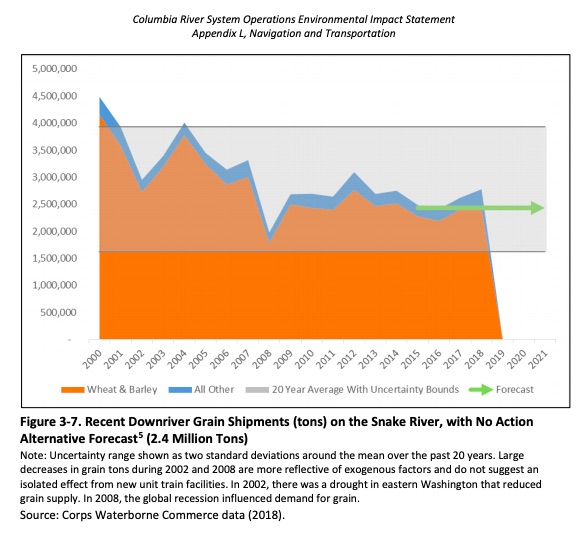forum
library
tutorial
contact

Snake River Dam Report
Leaves Many Costly Questions
by Editorial Board
Capital Press, September 1, 2022
|
the film forum library tutorial contact |

|
Snake River Dam Report
by Editorial Board
|
Barge rates average 30 to 45 cents a bushel,
while railroads charge 50 to 75 cents a bushel.
 In political parlance, it's called kicking the can down the road.
In political parlance, it's called kicking the can down the road.
And it's an expensive can at that.
That's when a politician looks for a way to put off an issue, at least temporarily.
That's what Washington Gov. Jay Inslee and U.S. Sen. Patty Murray have done with their report on breaching the four dams on the lower Snake River.
The issue has been a goal of some tribes and environmental groups as a way to help the salmon runs. They have opposed the dams since they were built nearly 60 years ago.
Unfortunately for them, if the dams were taken down the direct costs and the costs to the region's economy would dramatically outweigh any benefits to fish, according to the Inslee-Murray report.
"Replacing the services provided by the dams could range in cost from $10.3 billion to $31.3 billion, and anticipated costs are still not available for several necessary actions," according to the report.
In other words, they really don't know the total cost, which should make any taxpayer shudder.
Imagine, for a moment, that you were building a really nice house. The estimate from the contractor came in at $10 billion to $30 billion -- and a lot more that can't be determined.
No responsible person -- or irresponsible person, for that matter -- would commit to that, not even a politician. Open-ended estimates can be translated into two phrases: "We don't know the cost," and "Watch out."
Farther down in the report, the estimated cost of building either a 3-gigawatt -- the current peak generation load of the dams -- or a 14.9-gigawatt power plant to replace the electricity the dams generate came in at $9.3 billion to $56.9 billion. That range is so large it is meaningless.
Keeping the dams would cost $150 million to $278 million a year -- a bargain compared to the other numbers in the report.
Some expenses the report writers were able to figure out were disturbing.
That includes the cost of transporting wheat to export terminals downstream on the Columbia River.
Barge rates average 30 to 45 cents a bushel, while railroads charge 50 to 75 cents a bushel, the report found.
What the report didn't say is how unreliable most railroad service already is. It doesn't matter how much the railroad charges if the train never shows up, or shows up weeks late.
Another cost the report didn't include involved trucking the wheat downriver. The region's roads and highways would have to be rebuilt -- so would the railroads -- along with the added cost of trucking.
Replacing irrigation water from the Snake River would be done with deeper wells and reconfiguring irrigation systems at a cost of about $1 billion, according to the report. The report didn't say why Snake River water wouldn't be used.
Missing from the report is a guarantee that environmental groups would stop suing over the Columbia and Snake River dams. It was included in the initial proposal from U.S. Rep. Mike Simpson, R-Idaho, but has now disappeared.
So there you have it. Breaching the Snake River dams is too expensive for taxpayers, would cost farmers more in higher transportation and irrigation expenses, would cost electricity consumers in higher rates to build new generators, destroy a significant portion of the region's economy and possibly help fish runs.
And the total cost? Who knows?
learn more on topics covered in the film
see the video
read the script
learn the songs
discussion forum
